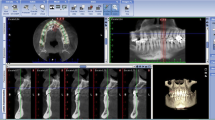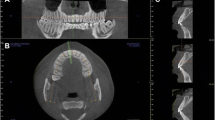Abstract
Objective
This retrospective study aimed to analyze the anatomical structure of the mandibular buccal shelf (MBS) in adolescents and adults with different vertical patterns to determine the optimal location for miniscrew insertion in orthodontic treatment.
Methods
Cone-beam computed tomography (CBCT) scans of 230 patients were utilized for measurements. The morphology and thickness of alveolar bone at the MBS were measured. Two-way ANOVA and regression analysis were conducted to analyze the influencing factors on alveolar bone and cortical bone thickness.
Results
Age had a significant effect on alveolar bone thickness (level I: F = 62.449, level II: F = 18.86, p < 0.001), cortical bone thickness (level II: F = 18.86, p < 0.001), alveolar bone tilt (F = 6.267, p = 0.013), and second molar tilt (F = 6.693, p = 0.01). Different vertical patterns also influenced alveolar bone thickness (level I: F = 20.950, level II: F = 28.470, p < 0.001), cortical bone thickness (level I: F = 23.911, level II: F = 23.370, p < 0.001), and alveolar bone tilt (F = 27.046, p < 0.001). As age increased, the alveolar bone thickness at level I decreased by 0.096 mm and at level II decreased by 0.073 mm. Conversely, the thickness of alveolar bone at level I and level II increased by 0.06 mm and 0.075 mm, respectively. The cortical bone thickness at level I and level II increased by 0.024 mm and 0.29 mm, respectively. However, the alveolar bone thickness decreased by 0.931 mm and 1.545 mm at level I and level II, and the cortical bone thickness decreased by 0.542 mm and 0.640 mm at level I and level II, respectively.
Conclusion
Age, different vertical patterns, alveolar bone inclination, and different shapes of MBS significantly affected the thickness of alveolar bone and cortical bone in the MBS area. Notably, only alveolar bone thickness and cortical bone thickness at level II were affected by age and different vertical patterns simultaneously. These findings can provide valuable insights for orthodontic practitioners in selecting the most suitable location for miniscrew insertion during treatment planning.





Similar content being viewed by others
Data availability
Data and methods not included in the manuscript are available on request from the authors.
References
Sung EH, Kim SJ, Chun YS, Park YC, Yu HS, Lee KJ. Distalization pattern of whole maxillary dentition according to force application points. Korean J Orthod. 2015;45(1):20–8.
Chung KR, Kim SH, Choo H, Kook YA, Cope JB. Distalization of the mandibular dentition with mini-implants to correct a Class III malocclusion with a midline deviation. Am J Orthod Dentofacial Orthop. 2010;137(1):135–46.
Nishimura M, Sannohe M, Nagasaka H, Igarashi K, Sugawara J. Nonextraction treatment with temporary skeletal anchorage devices to correct a Class II Division 2 malocclusion with excessive gingival display. Am J Orthod Dentofac Orthop. 2014;145(1):85–94.
Scheffler NR, Proffit WR, Phillips C. Outcomes and stability in patients with anterior open bite and long anterior face height treated with temporary anchorage devices and a maxillary intrusion splint. Am J Orthod Dentofac Orthop. 2014;146(5):594–602.
Jing Y, Han X, Guo Y, Li J, Bai D. Nonsurgical correction of a Class III malocclusion in an adult by miniscrew-assisted mandibular denti tion distalization. Am J Orthod Dentofac Orthop. 2013;143(6):877–87.
Maeda A, Sakoguchi Y, Miyawaki S. Patient with oligodontia treated with a miniscrew for unilateral mesial movement of the maxillary molars and alignment of an impacted third molar. Am J Orthod Dentofac Orthop. 2013;144(3):430–40.
Elshebiny T, Palomo JM, Baumgaertel S. Anatomic assessment of the mandibular buccal shelf for miniscrew insertion in white patients. Am J Orthod Dentofac Orthop. 2018;153(4):505–11.
Nucera R, Lo Giudice A, Bellocchio AM, Spinuzza P, Caprioglio A, Perillo L, Matarese G, Cordasco G. Bone and cortical bone thickness of mandibular buccal shelf for mini-screw insertion in adults. Angle Orthod. 2017;87(5):745–51.
Chen K, Cao Y. Class III malocclusion treated with distalization of the mandibular dentition with miniscrew anchorage: a 2-year follow-up. Am J Orthod Dentofac Orthop. 2015;148(6):1043–53.
Hosein YK, Smith A, Dunning CE, Tassi A. Insertion torques of self-drilling mini-implants in simulated mandibular bone: assessment of potentia l for implant fracture. Int J Oral Maxillofac Implants. 2016;31(3):e57-64.
Wu Y, Xu Z, Tan L, Tan L, Zhao Z, Yang P, Li Y, Tang T, Zhao L. Orthodontic mini-implant stability under continuous or intermittent loading: a histomorphometric and biomechanical analysis. Clin Implant Dent Relat Res. 2015;17(1):163–72.
Yi J, Ge M, Li M, Li C, Li Y, Li X, Zhao Z. Comparison of the success rate between self-drilling and self-tapping miniscrews: a systematic review and meta-analysis. Eur J Orthod. 2017;39(3):287–93.
Baumgaertel S. Predrilling of the implant site: is it necessary for orthodontic mini-implants? Am J Orthod Dentofacial Orthop. 2010;137(6):825–9.
Moon CH, Park HK, Nam JS, Im JS, Baek SH. Relationship between vertical skeletal pattern and success rate of orthodontic mini-implants. Am J Orthod Dentofac Orthop. 2010;138(1):51–7.
Jing Z, Wu Y, Jiang W, Zhao L, Jing D, Zhang N, Cao X, Xu Z, Zhao Z. Factors affecting the clinical success rate of miniscrew implants for orthodontic treatment. Int J Oral Maxillofac Implants. 2016;31(4):835–41.
Chen YJ, Chang HH, Huang CY, Hung HC, Lai EH, Yao CC. A retrospective analysis of the failure rate of three different orthodontic skeletal anchorage system s. Clin Oral Implants Res. 2007;18(6):768–75.
Chang C, Liu SS, Roberts WE. Primary failure rate for 1680 extra-alveolar mandibular buccal shelf mini-screws placed in movable mu cosa or attached gingiva. Angle Orthod. 2015;85(6):905–10.
Ozdemir F, Tozlu M, Germec-Cakan D. Cortical bone thickness of the alveolar process measured with cone-beam computed tomography in patients with different facial types. Am J Orthod Dentofac Orthop. 2013;143(2):190–6.
Gandhi V, Upadhyay M, Tadinada A, Yadav S. Variability associated with mandibular buccal shelf area width and height in subjects with different growth pattern, sex, and growth status. Am J Orthod Dentofac Orthop. 2021;159(1):59–70.
Aleluia RB, Duplat CB, Crusoé-Rebello I, Neves FS. Assessment of the mandibular buccal shelf for orthodontic anchorage: influence of side, gender and skeletal patterns. Orthod Craniofac Res. 2021;24(Suppl 1):83–91.
Vargas EOA, Lopes de Lima R, Nojima LI. Mandibular buccal shelf and infrazygomatic crest thicknesses in patients with different vertical facial heights. Am J Orthod Dentofac Orthop. 2020;158(3):349–56.
Moshiri M, Scarfe WC, Hilgers ML, Scheetz JP, Silveira AM, Farman AG. Accuracy of linear measurements from imaging plate and lateral cephalometric images derived from cone-beam computed tomography. Am J Orthod Dentofac. 2007;132(4):550–60.
Hilgers ML, Scarfe WC, Scheetz JP, Farman AG. Accuracy of linear temporomandibular joint measurements with cone beam computed tomography and digital cephalometric radiography. Am J Orthod Dentofac. 2005;128(6):803–11.
Sherrard JF, Rossouw PE, Benson BW, Carrillo R, Buschang PH. Accuracy and reliability of tooth and root lengths measured on cone-beam computed tomographs. Am J Orthod Dentofac. 2010;137(4 Suppl):S100–8.
Kobayashi K, Shimoda S, Nakagawa Y, Yamamoto A. Accuracy in measurement of distance using limited cone-beam computerized tomography. Int J Oral Maxillofac Implants. 2004;19(2):228–31.
Timock AM, Cook V, McDonald T, Leo MC, Crowe J, Benninger BL, Covell DA. Accuracy and reliability of buccal bone height and thickness measurements from cone-beam computed tomography imaging. Am J Orthod Dentofac. 2011;140(5):734–44.
Veyre-Goulet S, Fortin T, Thierry A. Accuracy of linear measurement provided by cone beam computed tomography to assess bone quantity in the posterior maxilla: a human cadaver study. Clin Implant Dent Relat. 2008;10(4):226–30.
Moreira CR, Sales MA, Lopes PM, Cavalcanti MG. Assessment of linear and angular measurements on three-dimensional cone-beam computed tomographic images. Oral Surg Oral Med. 2009;108(3):430–6.
Horn AJ. Facial height index. Am J Orthod Dentofac Orthop. 1992;102(2):180–6.
Masumoto T, Hayashi I, Kawamura A, Tanaka K, Kasai K. Relationships among facial type, buccolingual molar inclination, and cortical bone thickness of the mandible. Eur J Orthod. 2001;23(1):15–23.
MartínezPérez JA, Pérez Martin PS. Intraclass correlation coefficient. Med Fam-semergen. 2023;49(3):101907.
Ruquet M, Saliba-Serre B, Tardivo D, Foti B. Estimation of age using alveolar bone loss: forensic and anthropological applications. J Forens Sci. 2015;60(5):1305–9.
Custodio W, Gomes SG, Faot F, Garcia RC, Del Bel Cury AA. Occlusal force, electromyographic activity of masticatory muscles and mandibular flexure of subjects with different facial types. J Appl Oral Sci. 2011;19(4):343–9.
Gu YJ, Lu SN, Xia WQ, Zhang T, Shi H, Gao MQ. A study on the thickness of buccal bone in the mandible of different vertical facial type in adults using cone-beam CT. Shanghai Kou Qiang Yi Xue. 2015;24(3):335–7.
Escobar-Correa N, Ramírez-Bustamante MA, Sánchez-Uribe LA, Upegui-Zea JC, Vergara-Villarreal P, Ramírez-Ossa DM. Evaluation of mandibular buccal shelf characteristics in the Colombian population: a cone-beam computed tomography study. Korean J Orthod. 2021;51(1):23–31.
Zhang R, Chen X, Huang X. The cone-beam CT study on the slope of oblique plane at the mandibular buccal shelf area in 200 cases. Chin J Orthod. 2020;27(3):121–4.
Chen PJ, Lin JJ, Wong YK. Bone thickness of the buccal shelf for orthodontic implant placement. In: Annual meeting of Taiwan Association of Orthodontists; 2009.
Zambrano-De la Peña LS, Aliaga-Del Castillo A, Rodríguez-Cárdenas YA, Ruiz-Mora GA, Arriola-Guillén LE, Guerrero ME. Bucco alveolar bone thickness of mandibular impacted third molars with different inclinations: a CBCT study. Surg Radiol Anat. 2020;42(9):1051–6.
Motoyoshi M, Yoshida T, Ono A, Shimizu N. Effect of cortical bone thickness and implant placement torque on stability of orthodontic mini-implants. Int J Oral Maxillofac Implants. 2007;22(5):779–84.
Rossi M, Bruno G, De Stefani A, Perri A, Gracco A. Quantitative CBCT evaluation of maxillary and mandibular cortical bone thickness and density variability for orthodontic miniplate placement. Int Orthod. 2017;15(4):610–24.
Deguchi T, Nasu M, Murakami K, Yabuuchi T, Kamioka H, Takano-Yamamoto T. Quantitative evaluation of cortical bone thickness with computed tomographic scanning for orthodontic implants. Am J Orthod Dentofac Orthop. 2006;129(6):721.e7-12.
Swasty D, Lee JS, Huang JC, Maki K, Gansky SA, Hatcher D, Miller AJ. Anthropometric analysis of the human mandibular cortical bone as assessed by cone-beam computed tomography. J Oral Maxillofac Surg. 2009;67(3):491–500.
Farnsworth D, Rossouw PE, Ceen RF, Buschang PH. Cortical bone thickness at common miniscrew implant placement sites. Am J Orthod Dentofac Orthop. 2011;139(4):495–503.
Motoyoshi M, Hirabayashi M, Uemura M, Shimizu N. Recommended placement torque when tightening an orthodontic mini-implant. Clin Oral Implants Res. 2006;17(1):109–14.
Acknowledgements
This work was supported by Chinese Postdoctoral Science Foundation (no. 2018M642620), Qingdao Postdoctoral Applied Research Project, National Natural Science Foundation of China (no. 81700992), Qingdao Key Health Discipline Development Fund, Qingdao Clinical Research Center for Oral Diseases (22-3-7-lczx-7-nsh).
Funding
This work was supported by Chinese Postdoctoral Science Foundation (no. 2018M642620), Qingdao Postdoctoral Applied Research Project, National Natural Science Foundation of China (no. 81700992), Qingdao Key Health Discipline Development Fund, Qingdao Clinical Research Center for Oral Diseases (22-3-7-lczx-7-nsh).
Author information
Authors and Affiliations
Contributions
XXF: conceptualization, methodology, validation, investigation, writing. HD: methodology, validation, investigation. CHF: methodology, investigation. LP: formal analysis, resources, writing. TX: conceptualization, supervision, administration, funding acquisition. JLL: validation, investigation. JCM: conceptualization, methodology, investigation, resources, supervision, funding acquisition. All authors read and approved the final manuscript.
Corresponding authors
Ethics declarations
Conflict of interest
The authors declare that we have no competing interests.
Ethics approval and consent to participate
This study was approved by the institutional review board (QYFYwzll26491).
Additional information
Publisher's Note
Springer Nature remains neutral with regard to jurisdictional claims in published maps and institutional affiliations.
Rights and permissions
Springer Nature or its licensor (e.g. a society or other partner) holds exclusive rights to this article under a publishing agreement with the author(s) or other rightsholder(s); author self-archiving of the accepted manuscript version of this article is solely governed by the terms of such publishing agreement and applicable law.
About this article
Cite this article
Fang, X., Ding, H., Fan, C. et al. Comparison of mandibular buccal shelf morphology between adolescents and adults with different vertical patterns using CBCT. Oral Radiol 40, 58–68 (2024). https://doi.org/10.1007/s11282-023-00710-w
Received:
Accepted:
Published:
Issue Date:
DOI: https://doi.org/10.1007/s11282-023-00710-w




